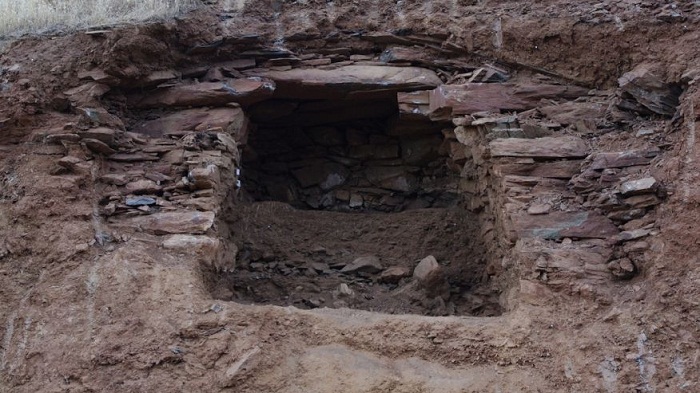"The snake-headed bracelet was very popular in Achaemenid times," and helped date the tomb, the team of archaeologists told Live Science in an email.
It`s difficult for archaeologists to tell exactly how many people were originally buried in the tomb, as some of the skeletons were found in a jumbled state. That disarray indicates that someone had entered, and possibly robbed, the tomb in ancient times, the researchers noted.
Inside the tomb, the archaeologists also found a pair of bronze earrings and the remains of at least 48 pottery vessels, five of which were still intact.
"There were five complete vessels found in the tomb: one bridge-spouted jar, three pitchers and one miniature jar. They were all found near the heads of skeletons," the archaeologists wrote.
This tomb probably didn`t belong to noblemen or wealthy individuals. "Based on the ceramics found and the limited amount of metal and other objects, these people were probably from a more modest background," the archaeologists wrote. The archaeologists aren`t sure yet whether the people were related to one another.
Layers of bones
Archaeologists found that sometime between 400 and 1,300 years ago, the tomb, originally the home of the six-plus skeletons found, was reused, and at least five more people (probably more) were buried there. The heads of those skeletons, which were separated from the older bones by a layer of soil, were found facing west. The archaeologists did not find any artifacts dating to the more recent burials.
"Based on the lack of artifacts found with the skeletons and their locations … the tomb reuse probably dates to the Early or Middle Islamic period [eighth to 17th century A.D.], but without artifacts or carbon samples, this cannot be proved," the archaeologists told Live Science.
The researchers cautioned, however, that the time period for the more recent burials "does not mean these are Islamic burials," they wrote. "Historically, in this region, various religious groups have lived together, including Muslims, Christians, Yazidis, Zoroastrians and many others."
Need for preservation
The tomb was excavated in the summer of 2013, after construction workers who were widening a road discovered it. Numerous archaeologists have told Live Science over the past few years that preservation is critical for the survival of heritage in northern Iraq .
Islamic State group (also known as ISIS, ISIL or Daesh) militants destroyed, damaged and looted many heritage sites after they conquered part of northern Iraq during a military campaign in the spring and summer of 2014. This particular tomb was not in an area they took over. At present, ISIS still controls part of Mosul and a few small cities, towns and rural areas in northern Iraq.
Numerous archaeologists have also told Live Science over the past few years that during the rule of Saddam Hussein, archaeologists had little access to parts of northern Iraq and that a number of sites are in desperate need of conservation. Moreover, as construction projects (such as the road widening that led to the discovery of this tomb) take place, new archaeological sites will be discovered.
More about:
















































